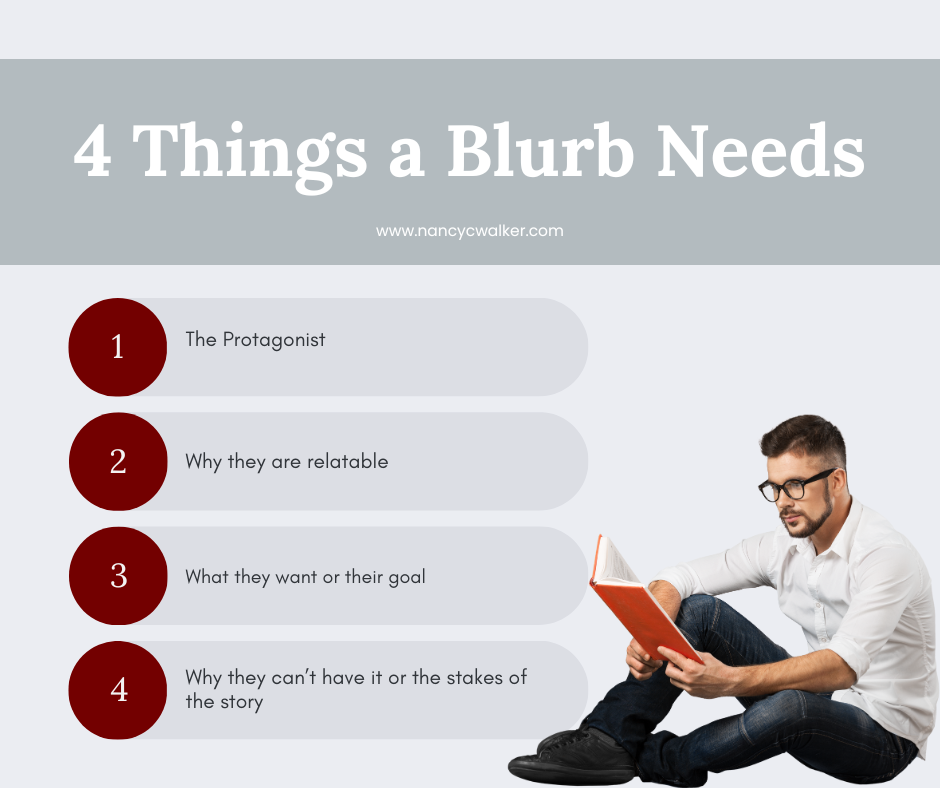Blurb writing differs from writing a novel, short story, or pretty much anything else. Blurbs don’t follow the same flow or rhythm as other writing, and many authors find them daunting. But they don’t have to be.
What is a Blurb?
According to the Oxford Dictionary, a blurb is “a short description of a book, movie, or other product written for promotional purposes and appearing on the cover of a book or in an advertisement.” (Oxford Dictionary). When readers search for a book to read, they often read the blurb either online, on the back of a paperback, on the inside flap of a hardcover book. This allows the reader to know general information about the book, and decide if they are interested. Online, the blurb may also feature information like content warnings, a tropes list, or other things the author wants readers to know. While it’s not traditional, it’s become an accepted practice, particularly with independently published works. One thing I see a lot is authors who confuse writing a blurb with writing a summary or an excerpt of their work.
The Parts of a Blurb
The blurb should be concise and focus on 4 main points. To start, write out the following. To illustrate the process, I’ll use the fairy tale of Cinderella.
1. The Protagonist
Write out who is the protagonist is.
The protagonist is Cinderella.
2. Why are they relatable?
Write out how the reader will relate to the protagonist. Think about the themes and tropes used in the story and play on them as you write the list. Is the book about racism? Then list the character’s race. Is a main trope in the story about parenting? Then list if the character is a parent, maybe the ages of the children, or if they are going through the process of pregnancy or adoption.
Cinderella is a beautiful young woman. Her step-mother forces her to be a servant. Her biological parents are deceased.
3. What does the protagonist want?
List out the goal of the character. Are they looking for love? A lost fortune? Or are they trying to survive something? Limit the answers to the main plot of the story. Avoid listing subplot goals, side quests, or the goals of characters other than the protagonist.
Cinderella wants to fall in love with a prince and escape the abuse of her stepmother and step-sisters.
4. Why can’t they have it? What are the stakes?
The answer to this question will be different depending on the story being told. If the story is a mystery, then the stakes may be that the detective will lose their job if they don’t solve the case. If it’s a romance, then maybe the person the protagonist wants to fall in love with is something they can’t have.
Cinderella’s stepmother and step-sisters actively present her as lower class, which makes her unfit to meet the prince. Cinderella’s status means that she doesn’t have the means to attend parties. If she doesn’t escape her step-family, then she will always be a servant and permanently lose her status.
Writing the Blurb
This is where we take the 4 elements and put them together. Pick one thing from each section to form a draft.
Cinderella, a beautiful young woman, wants to fall in love with a prince but must first find a way to meet one.
This blurb is not perfect, but it’s a start. Let’s try revising it.
When Cinderella is orphaned by the death of her father, her step-family makes her a servant and attempts to stop her from finding her prince. The only man who can save her from servitude.
This is better. We know what the story is about and can get excited about why step family doesn’t like her and how they are trying to stop her. We also have the double meaning of the word prince. Finding a prince is a phrase that often refers to finding true love, and in the story (**spoilers**) we know Cinderella finds a literal prince.
We could continue to play with the wording by changing out the points or rearranging the order they appear in. However, this is enough of an example to get you started. The things to remember are:
- The blurb is about the main plot. This is not a summary. The reader doesn’t need to know about side characters, subplots, or other elements that don’t apply to the dominant story.
- The blurb is brief. It’s not a summary or synopsis. Those are longer and more detailed. The blurb is a marketing piece that is used to entice the reader. If you tell them then ending of the story in the blurb, then why would they read the book?
- Be aware when adding elements to the blurb. Some authors add a paragraph to the blurb that contains content warnings, tropes lists, or other information they feel the reader may want to know when choosing a book. There is nothing wrong with this, as long as the blurb doesn’t get too long.
- Blurbs should match the story. If the blurb is ominous, then I expect the book to be. If the blurb is in 1st person, then I expect the book to be.
From here, the blurb for your book is up to you. Good luck!

